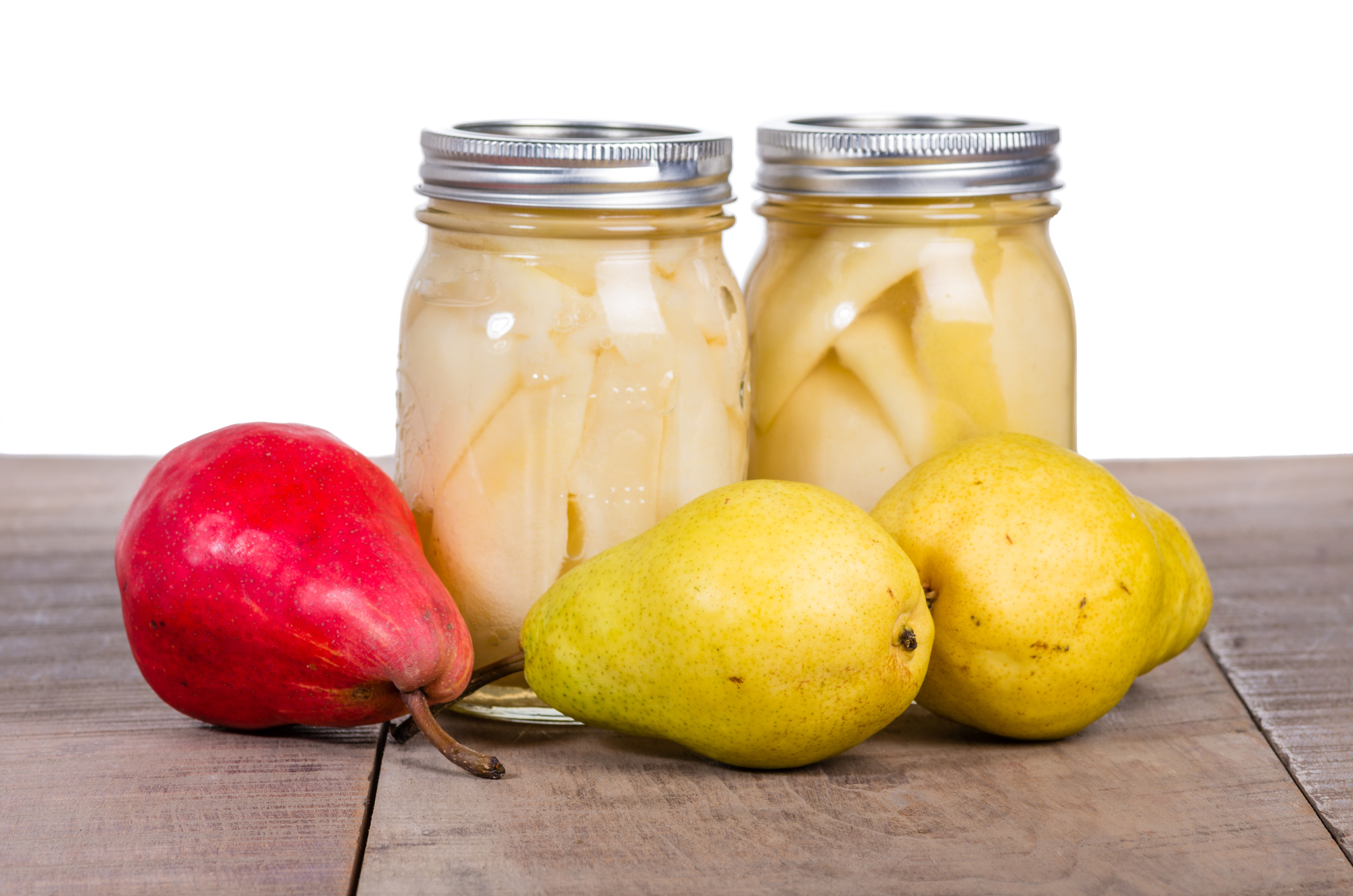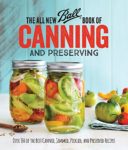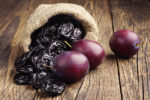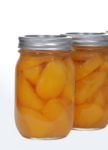
Home Canning: Fruits, Juices, Mincemeat, Cider
Commercial canning (in tin cans) was fairly common in the U.S. by the mid-1800s. In 1858, John L. Mason invented a glass jar that had a screw thread around the outside rim. This allowed a reusable metal lid to be screwed on, rather than having to use sealing wax. It became much easier for people to preserve their own pickles, relishes, sauces, and fruit. Later, people also began to can vegetables and meats.
INFORMATION BELOW FROM 1800s COOKBOOKS
TO STERILIZE JARS
Wash the jars, fill with cold water, place them on rests, such as small blocks of wood on the bottom of the kettle or boiler and surround them with cold water. If blocks of wood are not obtainable, the jars may be wrapped in brown paper to prevent them knocking against each other. Be sure the mouths of the jars are uncovered. Heat gradually until the water boils. Boil fifteen minutes or until ready to fill them. Sterilize the covers of the jars also, and dip the rubber bands in boiling water just before using.
DIRECTIONS FOR FILLING JARS
Remove the jars from the boiling water—the handle of a wooden spoon is good to use in removing them. Wring a cloth out of hot water and place it on a plate, and put the jar to be filled on the hot cloth. Put a silver spoon in it,—silver being a good conductor of heat absorbs the heat from the fruit and lessens the danger of breakage. Fill the jar with fruit and then add enough syrup or boiling water, as the case may be, to fill the jar to overflowing. Run a silver knife or spoon down the sides of the jar to allow any enclosed air to escape. Add more syrup or water, if necessary. Put on the sterilized rubber and seal tightly.
RUBBER RINGS
The rubber rings used to assist in keeping the air from the fruit jars sometimes become so dry and brittle as to be almost useless. They can be restored to normal condition usually by letting them lie in water in which you have put a little ammonia. Mix in this proportion: One part of ammonia and two parts water. Sometimes they do not need to lie in this more than five minutes, but frequently a half hour is needed to restore their elasticity.
CANNED FRUITS
Berries and all ripe, mellow fruit require but little cooking, only long enough for the sugar to penetrate. Strew sugar over them, allow them to stand a few hours, then merely scald with the sugar; half to three-quarters of a pound is considered sufficient. Harder fruits like pears, quinces, etc., require longer boiling. Fruit must be of fine flavor and ripe, though not soft, to make nice canned fruit.
CANNED STRAWBERRIES
After the berries are picked over, let as many as can be put carefully in the preserve kettle at once be placed on a platter. To each pound of fruit add three-fourths pound of sugar. Let them stand two or three hours till the juice is drawn from them. Pour the juice into the kettle and let it come to a boil. Remove the scum which rises, then put in the berries very carefully. As soon as they come thoroughly to a boil, put them in warm jars and seal while boiling hot.
CANNED PEACHES
Peaches should be thrown into cold water as they are peeled, to prevent a yellowish crust. To one pound of peaches allow half a pound of sugar and to six pounds of sugar, add half a tumbler of water. Put in the kettle a layer of sugar and one of peaches until the whole of both are in. Wash about eight peach leaves, tie them up and put into the kettle, remembering to take them out when you begin to fill up the jars. Let the sugared fruit remain on the range, but away from the fire, until upon tipping the vessel to one side you can see some liquid. Pour into warm glass jars while hot and seal tightly.
Although somewhat more expensive than tinned peaches, they are much nicer and keep for years with careful usage.
CANNED PLUMS
To every pound of plums allow one-fourth pound of sugar. Put the sugar and plums alternately into the preserving kettle, first pricking the plums to prevent their breaking. Let them stand on the back of the stove for an hour or two, then put them over a moderate fire and allow to come to a boil. Skim and pour at once into jars, running a silver spoon handle around the inside of the jar to break the air-bubbles. Cover and screw down the tops.
CANNED FRUIT JUICES
Canned fruit juices are an excellent substitute for brandy or wine in all puddings and sauces, etc. It is a good plan to can the pure juices of fruit in the summer time, putting it by for this purpose. Select clean ripe fruit, press out the juice and strain it through a flannel cloth. To each pint of juice add one cup of white granulated sugar. Put it in a porcelain kettle, bring it to the boiling point, and bottle while hot in small bottles. It must be sealed very tight while it is hot. Will keep a long time, the same as canned fruit.
CANNED MINCE MEAT
Mince meat for pies can be preserved for years if canned the same as fruit while hot, and put into glass jars and sealed perfectly tight, and set in a cool, dark place. One glass quart jar will hold enough to make two ordinary-sized pies, and in this way “mince pies” can be had in the middle of summer as well as in winter, and if the cans are sealed properly, the meat will be just as fine when opened as when first canned.
CANNED BOILED CIDER
Boiled cider, in our grandmothers’ time, was indispensable to the making of a good “mince pie,” adding the proper flavor and richness, which cannot be substituted by any other ingredient, and a gill of which being added to a rule of “fruit cake” makes it more moist, keeps longer, and is far superior to fruit cake made without it. Boiled cider is an article rarely found in the market, nowadays, but can be made by any one, with but little trouble and expense, using sweet cider, shortly after it is made, and before fermentation takes place. Place five quarts of sweet cider in a porcelain-lined kettle over the fire, boil it slowly until reduced to one quart, carefully watching it that it does not burn. Pour into glass jars while hot and seal tightly, the same as canned fruit. It is then ready to use any time of the year.
Image from Deposit Photos
=================================================

The All New Ball Book Of Canning And Preserving:
Over 200 of the Best Canned, Jammed, Pickled, and Preserved Recipes
From the experts at Jarden Home Brands, makers of Ball canning products, comes the first truly comprehensive canning guide created for today’s home cooks. This modern handbook boasts more than 350 of the best recipes ranging from jams and jellies to jerkies, pickles, salsas, and more-including extender recipes to create brand new dishes using your freshly preserved farmer’s market finds or vegetable garden bounty.
========================================
How to Make Mincemeat for Pies (With Meat)
Mock Mincemeat, Mince Pies Without Meat
========================================



